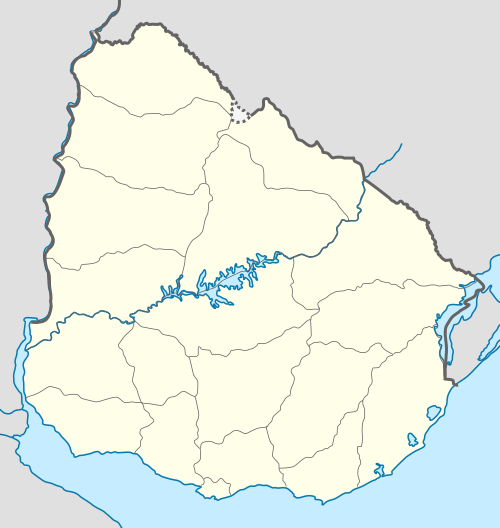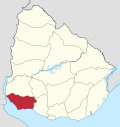Nueva Helvecia
Nueva Helvecia is a city in Colonia Department of Uruguay.
Nueva Helvecia | |
|---|---|
City | |
 Nueva Helvecia | |
| Coordinates: 34°17′S 57°12′W | |
| Country | |
| Department | |
| Founded | 1862 |
| Population (2011 Census) | |
| • Total | 10,630 |
Nueva Helvecia (Spanish for "New Helvetia"; formerly known as Colonia Suiza) is 120 kilometres (75 mi) west of Montevideo, the capital and largest city of Uruguay. It is a few kilometres from the coast where the Atlantic Ocean meets the Río de la Plata and east of Buenos Aires, Argentina. It is known nationwide for its Swiss heritage.
History
Swiss emigration
Europe was undergoing severe economic hardships during the second part of the 19th century. The Industrial Revolution affected many small artisans and family businesses. By law, Swiss mercenary soldiers could no longer fight for other countries and were returning home to find their families in precarious conditions that could not support any more members.
The Americas represented a chance for progress and prosperity. Many Swiss came to North America during the California Gold Rush, but once the Civil War started in the United States, the Swiss emigrants started looking further south in Argentina, Brazil and Uruguay for a better future. In Brazil there was a law that foreigners could not own land. In Argentina the colonists settled in indigenous territory and were not welcome, but Uruguay's government had a relatively open immigration policy. They were desperate to populate the country, which had but a few inhabitants at the time. The Swiss colony was given autonomy, and the first democratic secret vote in Uruguay happened in Colonia Suiza. The Swiss immigrants helped shape many Uruguayan laws, giving Uruguay the name of "Switzerland of the Americas", among many other contributions such as the classical production of Swiss cheese, also known as "Queso Colonia".
Settlement
The first Swiss settler was David Salomon Bratschi from Bern. He arrived in 1858, three years earlier than the first large group of settlers who arrived at the end of 1861.
However, the day of Nueva Helvecia's foundation is considered to be 24 April 1862. This date marks the time when a large number of immigrants, mostly from Switzerland, but with a significant number from Austria, Germany, Italy and France, settled in the area. The foundations of Colonia Suiza, Colonia Valdense, Colonia Miguelete, Rosario and other towns are the consequences of this European immigration. The name "Nueva Helvecia" was given to "Colonia Suiza" some decades later.
The arrival of Swiss, Austrian, Italian, French, and German immigrants was important to the subsequent political organization of a country that was receptive to foreign influences. Uruguay offered a range of alternatives to immigrants, like fertile lands for agriculture and grassland for livestock productivity.
Culture
The people of Nueva Helvecia have maintained Swiss traditions and customs to this day. There are several groups, including "Los Alegres Alpinos", and the "Alpenveilchen Grupo de Danzas", who still practice the songs and dances of their ancestors.
However, today, very few Nueva Helvecia residents speak the language of their ancestors, likely due to intermarriage with other populations. Even among Swiss the different dialects prevented them from communicating with each other unless they used the Spanish language.
The holidays and festivities include:
- The 25th of April, corresponding to the anniversary of the foundation of Nueva Helvecia
- The 1st of August, corresponding to the anniversary of the formation of the Swiss Confederation.
- The "Bierfest" in December attracts visitors from other departments and countries.
Architecture
The city, though located in Uruguay, shares a number of features and similarities with classical and early modern European architecture, mainly those of Switzerland, Germany and France, as a result of its close link with the cultures and societies of those countries. Unlike in other cities in Uruguay, every building bears a symbolic shield representing the different Swiss cantons where the family living in the house came from. This has become more evident in recent years.
Attractions
- Plaza de los Fundadores
- Tiro Suizo
- Hotel Suizo
- OSE Watertank
- Molino Quemado
- Evangelical Church
- Roman Catholic Church
- Cine Helvético[1]
Economy
Dairy products, including milk, Swiss cheese, cream cheese, dulce de leche, and yogurt, dominate the city's economy. Nueva Helvecia also produces a variety of sausages and animal products, fruits and vegetables, cereals and wine.
Until 1980 the Facansa enterprise produced bodywork for road vehicles.
Location and population
It is located in the southeastern part of Colonia Department, Uruguay. Its population, as of 2004, was 12,000.
Notable people
- Pedro Ignacio Wolcan Olano, (born 1953) bishop of Tacuarembó
- Rodrigo Bentancur (born 1997), association football player
- Horacio Troche (1935-2014), association football player and trainer
- Nibia Sabalsagaray (1949-1974), educator killed during the Uruguayan dictatorship
Sources
- Annaheim, Hans (1967). "Die Kolonie Nueva Helvecia in Uruguay". en Regio Basiliensis. 8: 27–76. ISSN 0034-3293.
- Arlettaz, Gérald (1979). "Emigration et colonisation suisses en Amérique 1815-1918". Etudes et Sources, Archives Fédérales Suisses. 5: 5–236. ISSN 1420-8725.
- Aschwanden, Prisca: Die schweizerische Einwanderung in Uruguay zwischen 1880-1929, Lizentiatsarbeit, Universität Zürich, 1990.
- Caro, Marice.: Los Bratschi en el Río de la Plata. David Salomón Bratschi, el primer colono suizo en la colonia agrícola de Nueva Helvecia. ISBN 978-0-692-48115-8
- Caro, Marice Ettlin.: The Swiss Colony of Uruguay. David Salomon Bratschi, the first settler of "Nueva Helvecia". ISBN 978-0-692-59318-9
- Caro, Marice Ettlin.: La Genealogia de los Ettlin, del canton de Unterwalden a la Americas. ISBN 978-0-692-54276-7
- Caro, Marice Ettlin.: The Ettlin Genealogy, from the Canton of Unterwalden to the Americas. ISBN 978-0-692-57332-7
- Caro, Marice Ettlin.: La Colonia Suiza que casi no lo fue: Nueva Helvecia. ISBN 978-0-692-78715-1
- Caro, Marice Ettlin.: Bienvenidos a Nueva Helvecia. ISBN 978-0-692-66079-9
- Wirth, Juan Carlos F.: Historia de la Iglesia Evangélica de Nueva Helvecia, 1944.
- Wirth, Juan Carlos F.: Colonia Suiza hace 80 años, 1947.
- Wirth, Juan Carlos F.: Historia de colonia suiza [de l'Uruguay], ed. por el Comité Ejucutivo pro-festejos del centenario de Colonia Suiza, Nueva Helvecia, 1962.
- Wirth, Juan Carlos F.: Del Havre al Río de la Plata en 47 días, 1974.
- Wirth, Juan Carlos F.: Génesis de la colonia agrícola suiza Nueva Helvecia: historia, documentos y carografia, Ministerio de Educación y Cultura, Montevideo, 1980.
- Zbinden, Carl: Die schweizerische Auswanderung nach Argentinien, Uruguays, Chili und Paraguay, dissertation, Universität Bern, Affoltern a. A., 1931.
- Ziegler, Sonia; Naón, Ignacio: Suizos en Uruguay, 224 pp., Montevideo, febrero de 2007. ISBN 9974-32-320-7
- Ziegler, Sonia .: Pequeña historias de Grandes mujeres. La historia de la Colonia Suiza en Uruguay a través de sus mujeres. ISBN 978-9974-98-594-0
References
- Caro, Marice (2015). Bienvenidos a Nueva Helvecia. USA: JFC Solutions. ISBN 978-0-692-66079-9.
External links
| Wikimedia Commons has media related to Nueva Helvecia, Uruguay. |
| Wikivoyage has a travel guide for Nueva Helvecia. |
- Nueva Helvecia in Swiss Info - (in Spanish)
- Guía turística de Colonia - (in Spanish)
- Pi Hugarte, Renzo; Vidart, Daniel (1970). El legado de los inmigrantes (PDF) (in Spanish). Montevideo: Nuestra Tierra.
